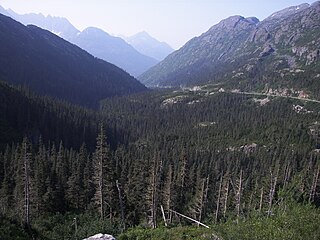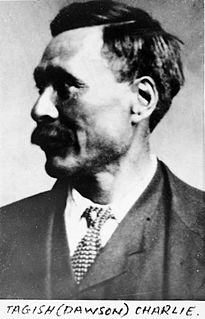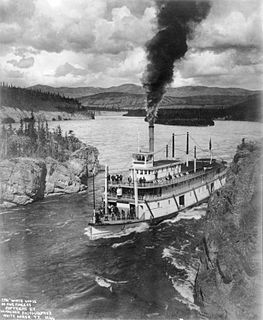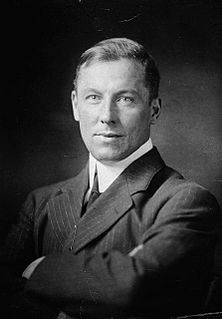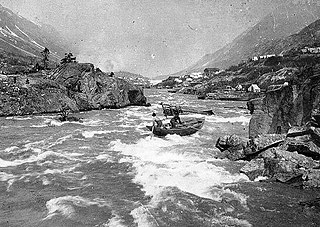
Joseph Francis "Joe" Ladue (July 28, 1855 – June 27, 1901) was a prospector, businessman and founder of Dawson City, Yukon, Canada.

Prospecting is the first stage of the geological analysis of a territory. It is the physical search for minerals, fossils, precious metals or mineral specimens, and is also known as fossicking.

Canada is a country in the northern part of North America. Its ten provinces and three territories extend from the Atlantic to the Pacific and northward into the Arctic Ocean, covering 9.98 million square kilometres, making it the world's second-largest country by total area. Canada's southern border with the United States is the world's longest bi-national land border. Its capital is Ottawa, and its three largest metropolitan areas are Toronto, Montreal, and Vancouver. As a whole, Canada is sparsely populated, the majority of its land area being dominated by forest and tundra. Consequently, its population is highly urbanized, with over 80 percent of its inhabitants concentrated in large and medium-sized cities, many near the southern border. Canada's climate varies widely across its vast area, ranging from arctic weather in the north, to hot summers in the southern regions, with four distinct seasons.
Ladue was born in Schuyler Falls, New York. His mother died when he was seven years old, and his father in 1874. Upon his father's death, 19-year-old Joe headed west.

Schuyler Falls is a town in Clinton County, New York, United States. The population was 5,181 at the 2010 census. The town was named after Peter Schuyler, who bought the mill on the Salmon River from Zephaniah Platt.
In 1876, he found employment in a gold mine in Deadwood, South Dakota, beginning as a general labourer and working his way up to engineer, foreman and superintendent. He eventually quit to go prospecting in Arizona and New Mexico, but did not strike it rich. In 1882, he crossed the Chilkoot Pass into the interior of the Yukon, where he prospected and traded for a couple of years.

Deadwood is a city in South Dakota, United States, and the county seat of Lawrence County. It was named by early settlers after the dead trees found in its gulch. The city had its heyday from 1876 to 1879, after gold deposits had been discovered there, leading to the Black Hills Gold Rush. At its height, the city had a population of 5,000, and attracted larger-than-life Old West figures including Wyatt Earp, Calamity Jane and Wild Bill Hickok.

Chilkoot Pass is a high mountain pass through the Boundary Ranges of the Coast Mountains in the U.S. state of Alaska and British Columbia, Canada. It is the highest point along the Chilkoot Trail that leads from Dyea, Alaska to Bennett Lake, British Columbia. The Chilkoot Trail was long a route used by the Tlingit for trade.

Yukon is the smallest and westernmost of Canada's three federal territories. It has the smallest population of any province or territory in Canada, with 35,874 people, although it has the largest city in any of the three territories. Whitehorse is the territorial capital and Yukon's only city.
In August 1896, a few days after the discovery of gold in the Klondike, he staked a claim to either 160 [1] or 178 [2] acres (65-72 hectares) of boggy flats at the mouth of the Klondike River as a townsite. In January 1897, he named the new town Dawson after Canadian geologist George Mercer Dawson. [1] By July, about 5000 people lived there. [3] Ladue could sell town lots for as much as $5000 [2] or $8000. [3] He relocated his saw mill to Dawson; it ran continuously night and day in response to the extreme demand. [3] He also set up a store and the first saloon in town. [1] In addition, he acquired a number of rich gold claims. [2] All this enabled Ladue to leave the north a rich man that year.

The Klondike Gold Rush was a migration by an estimated 100,000 prospectors to the Klondike region of the Yukon in north-western Canada between 1896 and 1899. Gold was discovered there by local miners on August 16, 1896, and, when news reached Seattle and San Francisco the following year, it triggered a stampede of prospectors. Some became wealthy, but the majority went in vain. It has been immortalized in photographs, books, films, and artifacts.
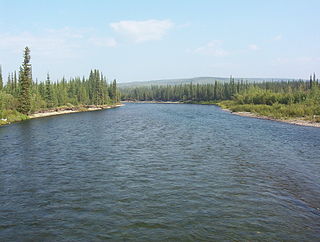
The Klondike River is a tributary of the Yukon River in Canada that gave its name to the Klondike Gold Rush. The Klondike River has its source in the Ogilvie Mountains and flows into the Yukon River at Dawson City.
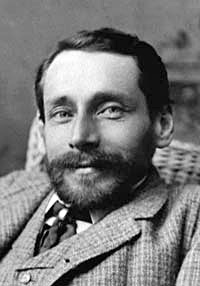
George Mercer Dawson was a Canadian geologist and surveyor. He was born in Pictou, Nova Scotia, the eldest son of Sir John William Dawson, Principal of McGill University and a noted geologist, and his wife, Lady Margaret Dawson. By age 11, he was afflicted with tuberculosis of the spine that resulted in a deformed back and stunted growth. Physical limitations, however, did not deter Dawson from becoming one of Canada's greatest scientists.
Ladue returned to his home town and on December 15, 1897, he married Anna "Kitty" Mason. [2] He was in poor health and died of "consumption" (tuberculosis) at Schuyler Falls on June 27, 1901. [2] He was survived by his wife and a son. [2]

Tuberculosis (TB) is an infectious disease usually caused by Mycobacterium tuberculosis (MTB) bacteria. Tuberculosis generally affects the lungs, but can also affect other parts of the body. Most infections do not have symptoms, in which case it is known as latent tuberculosis. About 10% of latent infections progress to active disease which, if left untreated, kills about half of those affected. The classic symptoms of active TB are a chronic cough with blood-containing sputum, fever, night sweats, and weight loss. It was historically called "consumption" due to the weight loss. Infection of other organs can cause a wide range of symptoms.

